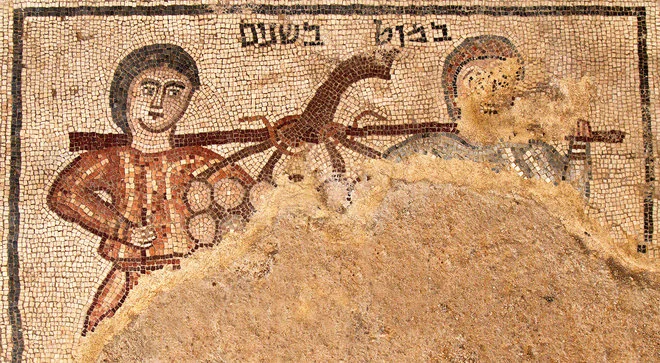(Photo: Jim Haberman)
By Laura Geggel, Senior Writer - July 11, 2018
An ancient mosaic depicting two Biblical spies sent to scout the Promised Land has been unearthed at a nearly 1,600-year-old synagogue in northern Israel.
In the mosaic, two spies carry a cluster of grapes on a pole — likely a reference to an episode in the Book of Numbers in the Hebrew Bible. In that passage, Moses asks 12 spies, including the famous Biblical hero Joshua, to scout out the land of Canaan. Moses had good reason for sending the reconnaissance mission: He wanted to know many people lived in Canaan, whether the soil there was fertile and what the fruit there tasted like, according to Numbers 13:17-13:23.
The mosaic shows two of those spies just after "they cut off a branch bearing a single cluster of grapes. Two of them carried it on a pole between them, along with some pomegranates and figs," according to the Bible's New International Version translation of Numbers 13:23.
The mosaic is one of about a dozen that archaeologists have uncovered at a synagogue in the ancient Jewish village of Huqoq, in Israel's Galilee. The detail and breadth of these discoveries indicate that the villagers flourished during the early fifth century A.D., when the region was under Rome's Christian rule.
"The mosaics decorating the floor of the Huqoq synagogue revolutionize our understanding of Judaism in this period," Jodi Magness, a professor of archaeology at the University of North Carolina at Chapel Hill who led the excavation, said in a statement. "Ancient Jewish art is often thought to be aniconic, or lacking images. But these mosaics, colorful and filled with figured scenes, attest to a rich visual culture as well as to the dynamism and diversity of Judaism in the late Roman and Byzantine periods."
Read More: Live Science

